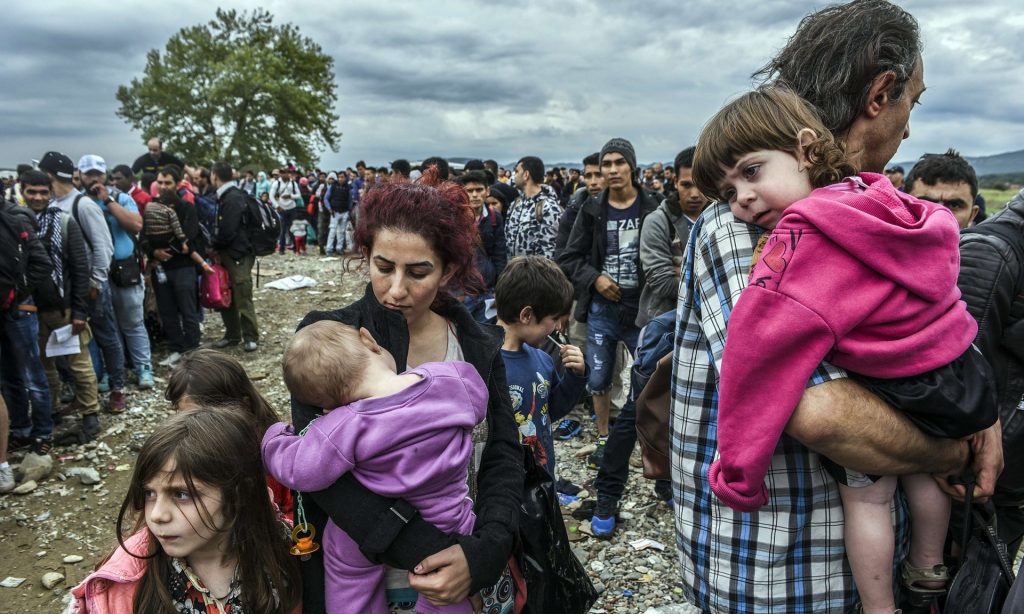
Photograph: Armend Nimani/AFP/Getty Images
Images of Syrians fleeing their homes and taking treacherous journeys in search of safety in Europe have dominated the news as levels of global displacement have escalated. Figures released on Monday by the UN refugee agency, the UNHCR, show that forced displacement affected more than 65 million people in 2015, the highest level ever recorded. Most of these people are in developing countries in their regions of origin.
With two landmark meetings in the offing, the world is facing tough decisions on how it responds to the crisis. In September, a gathering convened by the UN secretary general and a summit hosted by the US president, Barack Obama, will offer a chance to tackle the situation and strengthen global responsibility-sharing.
But how much do we really know about those affected and the resources available? Do we have enough information to develop an effective and forward-thinking response?
Estimates of the numbers of forced migrants – including refugees, asylum seekers and internally displaced people – are publicly available.
In addition to annual estimates by UNHCR on the number of people who have been forcibly displaced, Eurostat provides data on first-time asylum seekers registered in the EU, which are believed to have reached a record high of more than 1.2 million people last year (pdf).
The Internal Displacement Monitoring Centre collates data on the number of internally displaced people worldwide, which is estimated to have reached 40.8 million at the end of 2015, an increase of 2.8 million in a year.
However, the question of who gets counted is a politically charged issue. Difficulties in accessing populations within host communities and outside camps – or in counting non-registered refugees, people who have been repeatedly forced from their homes, and those who have been displaced for a long time – mean that some people are invisible, and ultimately do not get help.
The crux of the issue is that collecting data on refugees has traditionally been the domain of humanitarian organisations, on the one hand, as they sought to address immediate needs, and national asylum and immigration systems, on the other hand, as they tracked and processed claims.
This means that refugees are often omitted from national poverty surveys and other crucial studies, and so are left out of efforts to track the progress of people moving out of poverty. The longer-term livelihood needs of refugees and displaced people are not systematically addressed (pdf).
Given the burgeoning scale and protracted nature of the crisis, there is a pressing need for data on refugees and migrants to be a poverty and development issue – not just a humanitarian or migration concern.
The complexity of refugees’ needs demands a more sophisticated understanding of poverty and a repertoire of political, humanitarian and socio-economic responses, as well as evidence on the actual and potential economic contribution of refugees in their host countries.
As a step in the right direction, the World Bank and UNHCR undertook the first poverty and welfare assessment of a refugee population, in Jordan and Lebanon in December, drawing lessons for forced migrants elsewhere. New financing tools are emerging, bringing together multilateral banks, Islamic financing and aid donors.
But when looking at funding, and resources beyond humanitarian assistance, the availability and quality of data is also a challenge.
We do not have a full picture of what countries are spending on hosting refugees, or of donors’ responses to displacement elsewhere.
The only international platform for host countries to report spending does not give us all the facts. It only shows what can be counted as official development assistance and, within this, reporting practices vary dramatically (pdf). It doesn’t show the contributions of many developing countries, such as Lebanon and Pakistan, that host large numbers of refugees.
In addition, the data is out of date, since it is published a year after it is spent. In the absence of comparable and up-to-date data, not only do myths creep into the rhetoric, but it’s also hard to identify and fill financing gaps.
How can we improve the data on refugees to ensure that they aren’t left behind?
- Collect poverty data on refugees and migrants, and place this at the centre of decision-making. The inclusion of refugees and displaced people in national poverty surveys would, for example, ensure that their needs are reflected in national planning.
- Strengthen the timeliness of expenditure information by reporting to the international aid transparency initiative. This would enable all development and humanitarian resources, including refugee-hosting costs, to be tracked side-by-side in a timely manner.
Data on refugees and financing still won’t tell us the full story. But understanding the poverty of people forced to flee, and the investments needed to help them, would constitute a vital step in the right direction.
Sarah Dalrymple is a senior policy and engagement adviser on humanitarian and conflict issues at Development Initiatives, which will publish a report on trends in humanitarian financing on 27 June

